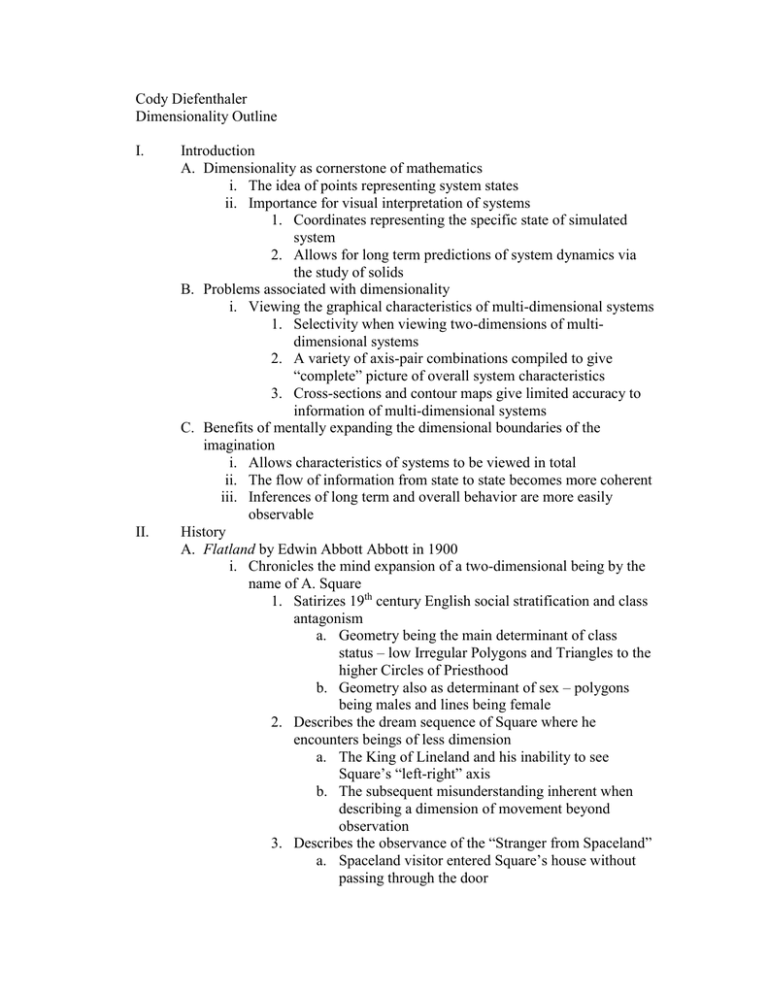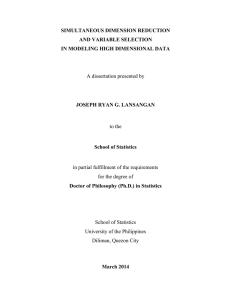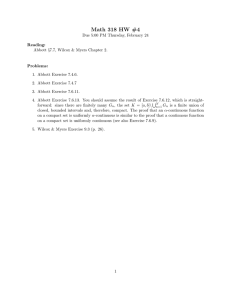CDiefenthalerOut1.doc
advertisement

Cody Diefenthaler Dimensionality Outline I. II. Introduction A. Dimensionality as cornerstone of mathematics i. The idea of points representing system states ii. Importance for visual interpretation of systems 1. Coordinates representing the specific state of simulated system 2. Allows for long term predictions of system dynamics via the study of solids B. Problems associated with dimensionality i. Viewing the graphical characteristics of multi-dimensional systems 1. Selectivity when viewing two-dimensions of multidimensional systems 2. A variety of axis-pair combinations compiled to give “complete” picture of overall system characteristics 3. Cross-sections and contour maps give limited accuracy to information of multi-dimensional systems C. Benefits of mentally expanding the dimensional boundaries of the imagination i. Allows characteristics of systems to be viewed in total ii. The flow of information from state to state becomes more coherent iii. Inferences of long term and overall behavior are more easily observable History A. Flatland by Edwin Abbott Abbott in 1900 i. Chronicles the mind expansion of a two-dimensional being by the name of A. Square 1. Satirizes 19th century English social stratification and class antagonism a. Geometry being the main determinant of class status – low Irregular Polygons and Triangles to the higher Circles of Priesthood b. Geometry also as determinant of sex – polygons being males and lines being female 2. Describes the dream sequence of Square where he encounters beings of less dimension a. The King of Lineland and his inability to see Square’s “left-right” axis b. The subsequent misunderstanding inherent when describing a dimension of movement beyond observation 3. Describes the observance of the “Stranger from Spaceland” a. Spaceland visitor entered Square’s house without passing through the door III. IV. b. Spaceland visitor also oscillated in size (radius) while in Square’s presence c. Square’s inability to see the oscillation as being representative of different cross sections of a third dimensional solids Viewing beyond three dimensions A. Inherent deception of vision i. King of Lineland’s vision 1. Point/No-point ii. A. Square’s vision 1. Line of infinitesimal “thickness” 2. Depth perceived as shading along the line iii. Human vision 1. Planar representation of reflected photons from objects to eyes 2. Stereo vision gives indication of depth B. Abbott’s lower-dimensional analogy to four-dimensional physical manifestations i. How vision must shift into the next dimension to view anomalies in their entire scope 1. 4D solids and their corresponding interpretations of system state and long term behavior Conclusion





